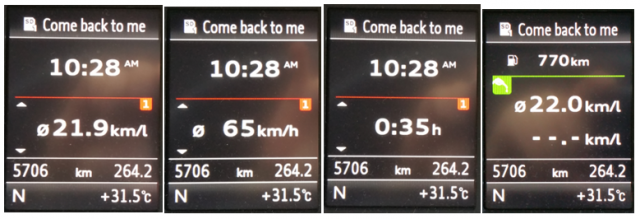Search the Community
Showing results for tags 'fuel consumption'.
-
7.5km/l on my last tank yikes! I can do bad fc but this is super duper bad on a tiny 1.5L car. Was on Esso 95 previously on the 7.5km/l, just pumped Caltex 95 + Techron Complete Fuel System Cleaner and monitoring but so far no improvements. Any suggestions to achieve better fuel consumption so that I can at least make it to KL in one tank? Deciding to stop at Ayer Keroh R&R for A&W should be by choice, not by force. 😆 Please help me get from very bad fc to okok fc hahaha. 🥴
- 376 replies
-
- 5
-

-

-
.png)
-
- fuel consumption
- caltex
-
(and 3 more)
Tagged with:
-
Just curious, I read some testers in China tested different cars on fuel consumption and claimed that different car brands and car models fuel consumption shown on the meter do not match the real consumption. Does anyone in singapore tested those? For example, how much fuel does you car drink in 1000/5000km? Vs how many litres you pumped?
-
This thread is set up for discussions of anything technical, features, functions, tips/tricks or technological gadgets relating to fuel consumption (FC) and performance for general drivers. It is not for the discussion extensive or extreme car modifications and similar irrelevances. Do share what works for you, your aspiration and related information. Do ask if you have any questions relating FC and performance.
- 127 replies
-
- 1
-

-
- fuel consumption
- performance
-
(and 2 more)
Tagged with:
-
Hi, we have all heard of various cars and their respective FC blah blah blah, but alot of them are hearsay or heard from someone from internet of review or from internet. And i realized not all the time these hearsay or myths are accurate. Example, i used to drive the old Nissan Sunny, before i buy, i already heard many hearsay or comments from internet saying it is a heavy petrol drinker. But for me, after buying it, i usually pumped 33-35litre of full tank, and i can cover average about 400-420km. It wasn't that bad actually right? And now i am driving Elantra, 2011 model. Full tank about 40-42litre...and i can cover 520km per full tank. I don't consider this very good. How about you guys? What car you driving and how much you spent every full tank and how much can it cover you?
- 293 replies
-
- 1
-

-
- fuel consumption
- fuel
-
(and 2 more)
Tagged with:
-

CNET lists its top five most efficient V8 powered cars
chitchatboy posted a blog entry in MyAutoBlog
V8-powered cars have always been known to be not fuel efficient. But CNET reckons it shouldn't stop you from owning one. Watch the video and see what are the top 5 cars that it thinks have a good balance of power, price and of course fuel consumption. By the way, the choice of vehicles ignores hybrids and diesels and to our surprise, only one car is not German and it ranks highest on the list. https://www.youtube.com/watch?v=0nf9ZuWwTH8 Now that you have seen this, wouldn't it be interesting to also have a listing of the least efficient V8 cars on sale, excluding diesels and hybrids? -
Hi, Please show how your Driver Information System looks like for your car incl. what kind of info is available for FC. I'll start off with mine. Car: Audi A3 sedan 1.4T (MY '15) Since: about 2 months ago. Single trip (non-peak traffic): 21.9km/L at avg speed of 65km/h over distance of ~35km. Long Term (since I got the car): 17.8km/L at avg speed of 36km/h over distance of ~5700km. Accuracy: ECU overestimate about 0.3 to 0.5km/L compared to manual pump calculation. Overall this car exceeded my most optimistic expectation on fuel economy esp. for a petrol engine. My previous 1.6L Jap car got me around 12-13km/L on the same driving pattern. I can never imagine a car can go over 1000 km per 50L tank under normal driving conditions. And I even turned off the irritating start-stop system which supposed can save more fuel.
- 1 reply
-
- fuel consumption
- driver information system
-
(and 5 more)
Tagged with:
-
Lets say car average petrol fc is 10km/l, how much time of idling in minutes will consume one litre of petrol?
- 131 replies
-
- 1
-

-
- fuel consumption
- car idling
- (and 2 more)
-
After making its debut in the MK 7 Golf Sport, VW's new 1.4 TSI with cylinder deactivation has found its way into the hoods of the Audi A1 and A3. The primary goal of the system is to reduce fuel consumption significantly by temporarily shutting off two of the four cylinders during low to mid loads. The greatest benefits are realised while driving at constant moderate speeds. The 1.4-litre unit is also fitted with a start-stop system. The 1.4-litre engine pumps out 138bhp at 5,000 rpm and 250Nm of torque between 1,500 and 3,500 rpm. Installed in the Audi A1, the mini hatchback with S-tronic goes from 0 to 100km/h in 7.9 seconds while the Sportback version takes just 0.1 second longer. For the Audi A3 and A3 Sportback, the century sprint takes 8.3 seconds and 8.4 seconds respectively. Looking at how the new engine replaces the 'Twincharger' in the Golf Sport, it won't come as a surprise if the same thing happens for the A1 S-Line. Volkswagen is the first carmaker to implement cylinder deactivation technology in a turbocharged four-cylinder engine in large-scale production.
-
- engine
- new technology
- (and 9 more)
-
Honda has released the details of its new 1.6-litre i-DTEC diesel engine, the first mass-produced engine from Honda's latest Earth Dreams series of fuel efficient powertrains. The new motor will be first utilized in the Civic come early 2013 and later on in the new CRV. The 1.6-litre unit is the lightest diesel engine in its class, thanks a variety of weight-saving measures. It has an aluminium cylinder head joined to an open deck aluminium block and the thickness of the cylinder walls has been reduced to 8mm as compared to 9mm for the 2.2-litre i-DTEC. This makes the engine 47 kg lighter than the 2.2-litre power plant. The engine is also equipped with a Garret turbocharger featuring an efficient variable-nozzle design. All these mean that the fuel economy is rated at an impressive 3.59L/100km while CO2 emission stands at 94 g/km. It churns out 120bhp at 4,000 rpm and has a peak torque of 300Nm at 2,000 rpm. Hyundai's award-winning 1.6-litre CRDI lump produces slightly more power at 126bhp but less torque at 264Nm. Designed specifically for the European market, the new engine will be produced at Honda's facility in Swindon, U.K., with an output of 500 units per day.
- 1 comment
-
- new technology
- engine
- (and 8 more)
-

The European Union imposes new tyre label regulation effective November 2012
SYF77 posted a blog entry in MyAutoBlog
Effective from November 2012, the European Union (EU) made it a requirement for tyres sold in the EU market to include a tyre label that specify their fuel consumption, wet grip and noise ratings. The label will use a classification from the best (green category 'A') to the worst performance (red category 'G'). The new initiative is part of the Energy Efficiency Action Plan drafted in 2009, which is designed to improve the energy performance of products, buildings and services to reduce energy consumption by 20% until 2020. The measure is believed to be a way to disadvantage the lower cost Asian tyre brands in the EU market. They are usually a lot cheaper than the European-made tyre but pales in comparison with the European brands in most aspects. According to the European Tyre and Rubber Manufacturers-
- other news
- discussions
- (and 10 more)
-
[extract] When a car is the market leader in its segment, it becomes an easy target for critics. In this case, it is the all new MK7 VW Golf. Unsatisfied with the fuel consumption of the new model, environmental activists from Greenpeace about 50 people picketed the premiere of the German hatchback in Berlin. Greenpeace's German transportation expert, Wolfgang Lohbeck, commented that Volkswagen has the technical knowledge to build a car whose base model could deliver a better fuel consumption than the advertised 4.9L/100km
-
Originally, start-stop technology was used on hybrid vehicles to enhance their fuel efficiency when they come to a halt. The technology is now spilling over to traditional vehicles to help them save fuel. Ford will offer start/start technology as an option on the 1.6 litre EcoBoost version of the 2013 Fusion (Mondeo in Europe). Priced at US$295, the start/stop option promises to improve fuel consumption by 3.5% to 10% depending on the driving patterns. Ford expects the reasonably priced option to be popular with buyers.
- 1 comment
-
- new model
- new technology
- (and 8 more)
-
[extract] The move towards better fuel consumption has prompted automakers to develop advanced internal combustion and hybrid technologies. But there is one more thing that affects fuel consumption and that is weight. Vehicle weight has always been an automaker
- 5 comments
-
- new technology
- other news
- (and 10 more)
-
[extract] There is no typo error in the title of this blog entry, in case you were wondering. In a recent interview with CNN
- 2 comments
-
- electric car
- discussions
- (and 5 more)
-
Fuel prices are always on the increase as our Earth's resources are being depleted and its really not the car you drive, but how you drive it. And using the brakes less saves you more money, and fuel. I've tried this and not only does it save money and petrol, it makes your driving much smoother as well. Instead of revving the engine at the lights just to get up to speed and then braking again in about 10m for another red light just wastes a ton of fuel. And by braking, its as good as dumping your fuel into the drain because you're just wasting the fuel that you used to get up to speed. So using the brakes less and controlling that heavy right hoof of yours will save you fuel. Of course you won't be going as fast but then again, why do you have to? On the expressway, maintaining a constant speed and watching out for cars braking far ahead will keep you from braking unnecessarily because you can lift off the throttle and cruise without wasting any petrol. On roads with loads of traffic lights, maybe just accelerating gradually instead of flooring the pedal could help retain some cash in your wallet.
- 8 comments
-
- driving styles
- saving fuel
-
(and 4 more)
Tagged with:
-
If you thought that having an ultra smooth surface that cuts through the air with razor sharp efficiency, you were wrong! As surprising as it may be, the Mythbusters on Discovery have found out that a car with dimples like those on a golf ball actually increases fuel efficiency. The original myth is that a car covered with dirt is more fuel efficient than a clean car because of the golf ball like dimpling effect that the dirt has on the car. However, they found out that dirt doesn't have any significant influence on the car's fuel efficiency. So as usual, they went to the extreme creating a car that actually had golf-ball like dimples on it by using clay. The standard car with the clay smeared on top without the dimples did 26mpg at a constant 65mph but after the dimples were created, the car did over 29mpg! The theory states that because of the dimples, it reduces the drag on the car thus making it more aerodynamic than say, a normal smooth shape. And it turns out to be Myth - Plausible. Quite amazing that they actually went out and did it. But can you imagine cars of the future looking like this just to improve a car's fuel efficiency? I don't think so but this looks amazing if you think of the principle behind it. It does look like a golf ball inspired car to the largest extent!
- 2 comments
-
- mythbusters
- fuel economy
- (and 4 more)
-
[extract] The recent mornings have been extra cooling due to the rain. Hence, there was one morning when I decided to give my car
- 4 comments
-
- aircon
- fuel economy
-
(and 2 more)
Tagged with:
-
The Centers for Disease Control and Prevention (CDC) recently released a new report on obesity in the U.S. According to the study, the U.S. witnessed a 1.1 percent increase in the number of self-reported people with obesity between 2007 and 2009. The increase amounts to 2.4 million additional Americans admitting that they have joined the category of obese individuals. In addition, the number of states reporting that at least 30 percent of its population fit into the obese category has tripled to include nine states. Rising obesity rates have led to increased medical costs and other public issues, but the automotive industry has felt the added weight as well. According to the study, an estimated one billion gallons of extra fuel were used up to compensate for the added weight of drivers and passengers from 1960 to 2002. If you look at it another way, 0.7 percent of all the fuel burned in vehicles from 1960 to 2002 has been attributable to passengers who have packed on a few extra pounds. From another angle, 39 million gallons of fuel are burned for each pound gained by the average American. So, if you are eco-conscious or intend to reduce fuel cost, think twice before you swallow that double cheese burger next time.
-
- fat
- fuel consumption
-
(and 1 more)
Tagged with:
-
Hyundai is declaring its ambition to be a tree-hugging company. The Korean automaker announced that it will continue its efforts to be the most fuel-efficient automaker in America through the next two decades, with plans to achieve a Corporate Average Fuel Economy rating of 50 miles per gallon by 2025 for its entire vehicle lineup. The cornerstone of Hyundai's approach is its Blue Drive strategy, which incorporates a range of engine technologies from turbocharging to direct-injection, lightweight materials and plug-in hybrids to reduce consumption and improve overall efficiency. Hyundai points to the 2011 Sonata as the first wave of new products to utilize its new and improved drivetrains, available with either hybrid, turbocharged or naturally aspirated engines. The latest 1.6L GDI engine in the new Avante is also a shining example of Hyundai







